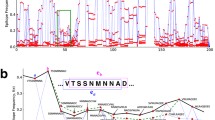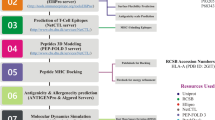Abstract
EPIPOX is a specialized online resource intended to facilitate the design of epitope-based vaccines against orthopoxviruses. EPIPOX is built upon a collection of T cell epitopes that are shared by eight pathogenic orthopoxviruses, including variola minor and major strains, monkeypox, cowpox, and vaccinia viruses. In EPIPOX, users can select T cell epitopes attending to the predicted binding to distinct major histocompatibility molecules (MHC) and according to various features that may have an impact on epitope immunogenicity. Among others, EPIPOX allows to discern epitopes by their structural location in the virion and the temporal expression of the counterpart antigens. Overall, the annotations in EPIPOX are optimized to facilitate the rational design of T cell epitope-based vaccines. In this chapter, we describe the main features of EPIPOX and exemplify its use, retrieving orthopoxvirus-specific T cell epitopes with features set to enhance their immunogenicity. EPIPOX is available for free public use at http://bio.med.ucm.es/epipox/.
Laura Ballesteros-Sanabria and Hector F. Pelaez-Prestel contributed equally to the chapter.
Access this chapter
Tax calculation will be finalised at checkout
Purchases are for personal use only
Similar content being viewed by others
References
Theves C, Biagini P, Crubezy E (2014) The rediscovery of smallpox. Clin Microbiol Infect 20(3):210–218
Buller RM, Palumbo GJ (1991) Poxvirus pathogenesis. Microbiol Rev 55(1):80–122
Riedel S (2005) Edward Jenner and the history of smallpox and vaccination. Proc (Bayl Univ Med Cent) 18(1):21–25
Diaz JH (2021) The disease ecology, epidemiology, clinical manifestations, management, prevention, and control of increasing human infections with animal orthopoxviruses. Wilderness Environ Med 32(4):528–536
Molero-Abraham M, Glutting JP, Flower DR, Lafuente EM, Reche PA (2015) EPIPOX: immunoinformatic characterization of the shared T-cell epitome between variola virus and related pathogenic orthopoxviruses. J Immunol Res 2015:738020
Jenner E (1801) On the origin of the vaccine inoculation. Med Phys J 5(28):505–508
Alzhanova D, Fruh K (2010) Modulation of the host immune response by cowpox virus. Microbes Infect 12(12–13):900–909
Schrick L, Tausch SH, Dabrowski PW, Damaso CR, Esparza J, Nitsche A (2017) An early American smallpox vaccine based on horsepox. N Engl J Med 377(15):1491–1492
Maurer DM, Harrington B, Lane JM (2003) Smallpox vaccine: contraindications, administration, and adverse reactions. Am Fam Physician 68(5):889–896
Bray M, Wright ME (2003) Progressive vaccinia. Clin Infect Dis 36(6):766–774
Bunge EM, Hoet B, Chen L, Lienert F, Weidenthaler H, Baer LR et al (2022) The changing epidemiology of human monkeypox-a potential threat? A systematic review. PLoS Negl Trop Dis 16(2):e0010141
Ballesteros-Sanabria L, Pelaez-Prestel HF, Ras-Carmona A, Reche PA (2022) Resilience of spike-specific immunity induced by COVID-19 vaccines against SARS-CoV-2 variants. Biomedicine 10(5):996
Vita R, Overton JA, Greenbaum JA, Ponomarenko J, Clark JD, Cantrell JR et al (2015) The immune epitope database (IEDB) 3.0. Nucleic Acids Res 43(Database issue):D405–D412
Jing L, Davies DH, Chong TM, Chun S, McClurkan CL, Huang J et al (2008) An extremely diverse CD4 response to vaccinia virus in humans is revealed by proteome-wide T-cell profiling. J Virol 82(14):7120–7134
Oseroff C, Kos F, Bui HH, Peters B, Pasquetto V, Glenn J et al (2005) HLA class I-restricted responses to vaccinia recognize a broad array of proteins mainly involved in virulence and viral gene regulation. Proc Natl Acad Sci U S A 102(39):13980–13985
Smith CL, Mirza F, Pasquetto V, Tscharke DC, Palmowski MJ, Dunbar PR et al (2005) Immunodominance of poxviral-specific CTL in a human trial of recombinant-modified vaccinia Ankara. J Immunol 175(12):8431–8437
Kim M, Yang H, Kim SK, Reche PA, Tirabassi RS, Hussey RE et al (2004) Biochemical and functional analysis of smallpox growth factor (SPGF) and anti-SPGF monoclonal antibodies. J Biol Chem 279(24):25838–25848
Yang H, Kim SK, Kim M, Reche PA, Morehead TJ, Damon IK et al (2005) Antiviral chemotherapy facilitates control of poxvirus infections through inhibition of cellular signal transduction. J Clin Invest 115(2):379–387
Kastenmuller W, Gasteiger G, Gronau JH, Baier R, Ljapoci R, Busch DH et al (2007) Cross-competition of CD8+ T cells shapes the immunodominance hierarchy during boost vaccination. J Exp Med 204(9):2187–2198
Acknowledgments
We are thankful to the ANTICIPA-CM project of Complutense University of Madrid for supporting L.B-S. H.P-P is supported by FPU 2019 Grant.
Author information
Authors and Affiliations
Corresponding authors
Editor information
Editors and Affiliations
Rights and permissions
Copyright information
© 2023 The Author(s), under exclusive license to Springer Science+Business Media, LLC, part of Springer Nature
About this protocol
Cite this protocol
Ballesteros-Sanabria, L., Pelaez-Prestel, H.F., Reche, P.A., Lafuente, E.M. (2023). EPIPOX: A Resource Facilitating Epitope-Vaccine Design Against Human Pathogenic Orthopoxviruses. In: Reche, P.A. (eds) Computational Vaccine Design. Methods in Molecular Biology, vol 2673. Humana, New York, NY. https://doi.org/10.1007/978-1-0716-3239-0_12
Download citation
DOI: https://doi.org/10.1007/978-1-0716-3239-0_12
Published:
Publisher Name: Humana, New York, NY
Print ISBN: 978-1-0716-3238-3
Online ISBN: 978-1-0716-3239-0
eBook Packages: Springer Protocols




